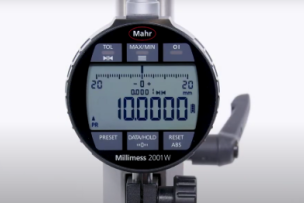Headquartered in Aurora, IL, Mitutoyo America Corporation is the world's largest provider of measurement and inspection solutions offering the most complete selection of machines, sensors, systems and services with a line encompassing CMM (coordinate measuring machines), vision, form and finish measuring machines, as well as precision tools and instruments, and metrology data management software. Mitutoyo's nationwide network of Metrology Centers and support operations provides application, calibration, service, repair and educational programs to ensure that our 8,500+ metrology products will deliver measurement solutions for our customers throughout their lifetime.
CMMs offer a capable, affordable and flexible gear inspection option.
Gear inspection has long been considered a highly specialized, expensive and difficult part of the gear manufacturing process, requiring a wide variety of complicated gages, testers, dedicated CNC equipment and highly trained experts.
But if you want to make good gears, you need to have all that stuff, right?
Well, maybe not, says John Fox, senior CMM software application engineer for Mitutoyo America Corporation. According to Fox, the time may be right to consider a coordinate measuring machine (CMM) for your gear inspection needs.
“We have many customers who are using a CMM for gear measurement, production and setup,” Fox says. “Customers including Honda, Kawasaki, Hitachi, Molon Motors, etc. use the CMM to measure purchased gears. And there are high-precision gear companies, such as Gear Manufacturers Inc., that incorporate our higher-accuracy CMM for setup and some production.”
A lower price tag is one of the main reasons to consider CMMs over conventional dedicated gear inspection equipment, Fox says. A single piece of today’s sophisticated, fully programmable, fully automated dedicated gear-checking equipment, limited to a single gear size range (gears up to 15 inch diameter, for example) plus software, might cost twice as much as a CMM machine equipped with a rotary table, high-speed scanning probe head and gear-checking software, Fox says. Of course, exact prices for either type of system depend on options and machine size.
The type of CMM used to measure gears depends mostly on the part’s size and weight. When measuring large gears—those with diameters of more than a meter or which are extremely heavy—a high-precision, horizontal-arm CMM with a rotary table would be required. This style of CMM is generally used for inspecting large-scale gears such as those used in ship and heavy equipment powertrains, turbine gearing and gears used in nuclear and thermal power plants and wind turbines. Inspection of large-scale gears is easier to perform with this style of CMM due to its open-access structure.
On the other hand, bridge CMMs are usually the right machine for measuring small or medium-size gears. Two styles of bridge-type CMMs are available. One has a fixed table with moving bridge, and the other has a moving table with a fixed bridge. This second style of CMM offers greater accuracy. Some models of bridge CMMs have quite large capacities, overcoming the need for a horizontal arm machine.
In addition to replacing dedicated gear inspection equipment, CMMs can also replace many of the smaller, handheld and functional gages often used in gear inspection. “Handheld gages are subject to operator interpretation,” Fox says. “Repeatability between operators using manual inspection methods is lower. Speed of measurement is certainly slower. Written reporting is open to incorrect values being recorded. An automated CMM can be measuring parts, while the operator continues to produce parts. Once the CMM program is proven out, you know you will get good accuracy, repeatability and reporting.”
In some cases, the CMM can even be placed right on the shop floor, alongside production machines.
“The two major enemies for a CMM are rapid and dramatic temperature changes and vibration,” Fox says. “Even when on a shop floor, if the temperature is somewhat stable, there is no major noticeable error. Mitutoyo equipment has temperature sensors on each scale. Therefore, proper compensation is made for temperature fluctuations. Mitutoyo has many customers that place the CMMs on the shop floor and are very pleased with the repeatability and accuracy obtained. Mitutoyo manufactures a specific CMM, the Strato, which is made for use on a shop floor. The Strato scales incorporate non-expanding glass scales; the ways are completely protected with covers and bellows and active vibration dampening using auto leveling air spring units.”
Take another look
Those who might have considered CMMs in the past should definitely take another look, Fox says.
“In the past 5-10 years, Mitutoyo CMMs have become much more precise with the incorporation of high-performance controllers, greater scanning technology, minimizing internal heat generation, faster servo drive mechanisms with accelerations of up to 2.598 mm/sec2,” Fox says.
With regard to precision, Mitutoyo makes both high-accuracy CMMs as well as commodity-level equipment. The commodity-level machines allow a maximum permissible error (MPEE) of 1.7+3L/1,000 microns, while Mitutoyo’s mid-range and high-accuracy machines allow 0.9+2.5L/1,000 microns and 0.6+1.5L/1,000 microns, respectively.
“It is because of the accuracy at the mid-range and high end that Mitutoyo CMMs are very well suited for the extremely tight tolerances required for gear measurement,” Fox says.
“One thing to be aware of is Mitutoyo manufactures every component that is used in all Mitutoyo equipment, including all of our CMMs,” Fox says. “We have excellent control over the quality of the components that go into our CMMs. This enables Mitutoyo CMMs to have the longest meantime between failures, which is from 25,000 to 30,000 hours.”
Some of the key ingredients to Mitutoyo machines’ accuracy include machine construction and precision components. “The Y axis is cut and ground from the same piece of granite as the plate,” Fox says. “The Y axis will never change because of this, unlike CMM manufacturers that use a separate piece of granite that is glued and attached by lag bolts. In addition, Mitutoyo has always produced the best scales, which have minimal to no expansion. Mitutoyo incorporates temperature compensation on each scale.”








Talk to Us!
Leave a reply
Your email address will not be published. Required fields are marked *